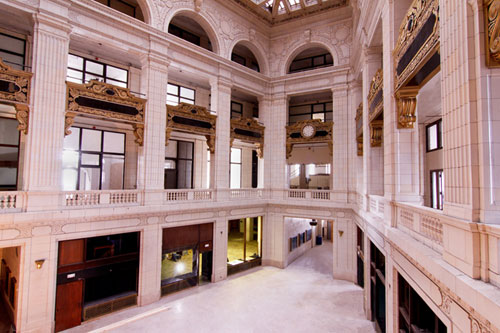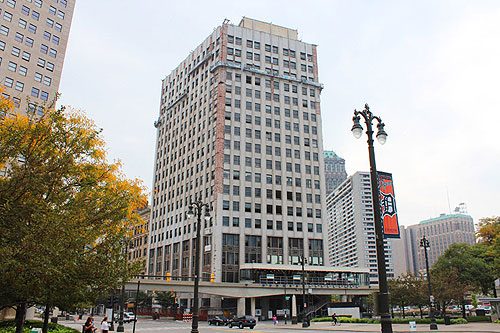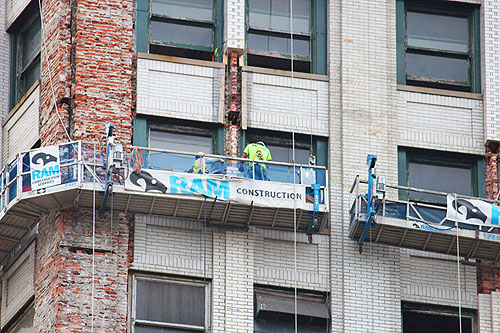Residential, retail next purpose for revamped Whitney Building
Date Posted: October 18 2013
DETROIT – Nearly a century after it opened, it’s the David Whitney Building’s turn to make a triumphant resurrection.
Like so many buildings in downtown Detroit that have been renovated, re-purposed and re-opened in recent years, the Whitney is currently undergoing work that will make it a valuable piece of property once again.
The 19-story tower opened in 1915, providing retail space and professional offices for doctors, dentists and lawyers on the ring of buildings at Grand Circus Park. Along with a fellow “David” building across Woodward – the newly renovated 34-story David Broderick Tower – the pair of buildings have until recently been empty anchors of Grand Circus Park. The Whitney building’s tenants dwindled over the years, leading to its closure in 2000.
Now, the Roxbury Group and hotel management company Trans Inns Management are undertaking a wholesale, $82 million renovation of the Whitney building, creating ground-floor retail space, a 136-room boutique hotel on the first nine floors, and 108 apartments on the top nine floors. Construction manager Walbridge is overseeing the project, utilizing a 100 percent union workforce.
It took much of the past decade to arrange the financing and the right deal to redevelop the property. David DiRita, a partner in the Roxbury Group, said the project would “mark the dawn of Detroit's next golden age.”
The building was named for 19th Century lumber baron David Whitney. “Done in the Chicago skyscraper style and completed in 1915,” says the Detroit Historical Society, “the David Whitney Building was designed with a five-story atrium area where shops could be located. The atrium was done in white tile, terra cotta and marble in the Italian Renaissance style. The public corridors in the building had Italian marble floors and walls. For several decades, the Whitney was a prestigious location for medical offices. Through several decades of changes and additional years of vacancy, the building has remained full of potential.”
Now the potential is becoming reality. Walbridge will maintain and where necessary, refurbish all the doors, woodwork, and extensive terra cotta and marble elements found on public spaces in the interior. The exterior, mostly brick with some terra cotta, is being rehabilitated, and horizontal architectural cornices on four levels that were removed in the 1950s will be recreated to add definition to the exterior.
The building was originally designed by famed architect Daniel Burnham.
“It was a tired building, and we’re at the beginning of the refreshing process,” said Walbridge Senior Project Manager Michael Colombo. “After 100 years, it’s beginning to reveal itself again. It’s a well-known building, and a lot of people are glad that it’s being resurrected. We’re happy to be a part of it.”
Renovation work began in March with hazardous materials abatement, a process that was ongoing earlier this month. Other ongoing projects include some steel reinforcement in the basement, as well as the start of sprinkler, plumbing, sheetmetal and electrical rough-in work. Masons are also busy on the exterior. About 80 Hardhats are currently employed, and the project will peak out at about 100. Work is expected to be complete next July.
Colombo, along with Walbridge Project Supt. Jason Arsenault, said the location of the building creates a number of challenges, including the use of part of the building’s first and second floors as a People Mover stop. “Logistically, we have streets on three sides of the building, we have neighbors we’re sensitive to (including dwellers in the Broderick Tower) and we have Comerica Park just over there. We have the People Mover. There’s a lot of traffic,” Colombo said.
Unlike other empty buildings in downtown Detroit which have been gutted by urban scavengers or left open to the weather, the Whitney Building’s interior has remained in relatively good condition. The basement, for example, remained dry over all these years. “It’s a very proud building, with a lot of character and good bones,” Arsenault said.
The building’s exterior has a few issues, both in terms of the removed cornices and the condition of the brick. Ram Construction has the contract for rehabilitation, removal and replacement of faulty exterior brick, and adding the aforementioned cornices.
A Ram spokesman said the initial scope of the project identified about 11,000 square-feet of “disbonded” brick on the exterior, which need to replaced due to cracks, fatigue or oxidation. That number has since “ballooned” the spokesman said, as masons have probed the walls. Bricks fell from the east side of the building two years ago before any renovation work started. Brick Tech is a local firm that is making thousands of white speckled brick to match the original. A good cleaning of the masonry will make the building look as good as new.
“While it was spared the wrecking ball, in 1959, the Whitney family hired the architectural firm of Harley, Ellington & Day to give the structure a modern makeover,” says the Detroit Historical Society. “The building’s classical exterior was removed in favor of a more modern, bland look. The building’s classical columns were replaced with plain brick. The cornice, parapet and terra cotta details were removed. Fortunately, the building’s ornate interior was spared the mutilation.”
And by next summer, the David Whitney Building will be renovated, restored and ready for the next 100 years – inside and out.

THE REMARKABLE marble and terra cotta atrium in the century-old David Whitney Building in Detroit is the signature feature of the 19-story tower. This photo was taken before the renovation process began, showing the area to be in very good condition. Among the original 1915 tenants in these retail shops: Capper & Capper men’s furnishings, G.M. Schettler Drugs, Rogers Shoe Co. and the Watkins Cigar Stores Co.
Photo courtesy Walbridge

THE 19-STORY David Whitney Building’s exterior was stripped of much of its architectural ornamentation in the late 1950s. Much of it will be restored in this renovation.
 REHABILITATION OF BRICK on the exterior of the David Whitney Building has been ongoing for most of this year. Doing the work are members of Bricklayers and Allied Craftworkers Local 2, working for Ram Construction. Most of the exterior is covered with speckled white brick, which is being matched with new brick where replacements have to be made. Architectural cornices which were removed in the 1950s will also be recreated and installed on the exterior.
REHABILITATION OF BRICK on the exterior of the David Whitney Building has been ongoing for most of this year. Doing the work are members of Bricklayers and Allied Craftworkers Local 2, working for Ram Construction. Most of the exterior is covered with speckled white brick, which is being matched with new brick where replacements have to be made. Architectural cornices which were removed in the 1950s will also be recreated and installed on the exterior.
